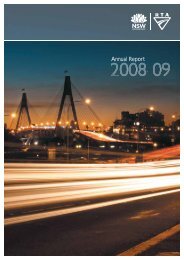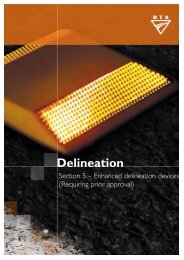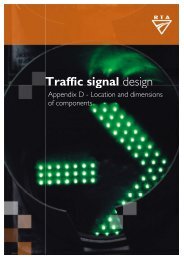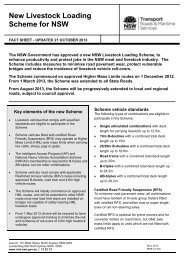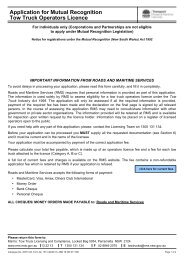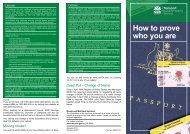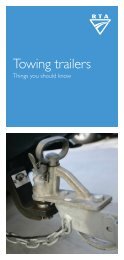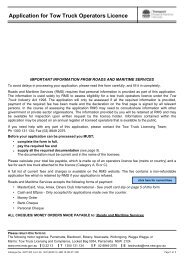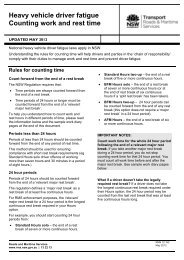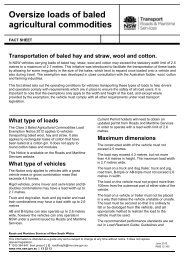Annual Report 2006 (main body) - RTA - NSW Government
Annual Report 2006 (main body) - RTA - NSW Government
Annual Report 2006 (main body) - RTA - NSW Government
Create successful ePaper yourself
Turn your PDF publications into a flip-book with our unique Google optimized e-Paper software.
Noise Abatement Program Geodatabase<br />
The <strong>RTA</strong>’s NAP Geodatabase captures<br />
and efficiently manages information<br />
gathered on several facets of the NAP.<br />
The geodatabase applications allow the<br />
user to visualise the extent of noise wall<br />
development, identify buildings that<br />
have received architectural treatment,<br />
identify historical noise complaints and<br />
noise monitoring site locations. During<br />
the year improvements were made to<br />
the geodatabase. This includes a new<br />
capability of detailing length, area and<br />
estimated replacement cost of noise wall<br />
infrastructure in <strong>NSW</strong>.<br />
NATURAL RESOURCES<br />
AND WASTE<br />
WASTE<br />
The <strong>RTA</strong> has a statutory requirement<br />
under the Waste Avoidance and Resource<br />
Recovery Act 2001 to report on the<br />
implementation of the Waste Reduction<br />
and Purchasing Policy (WRAPP). Details<br />
are found in Appendix 3.<br />
In summary, it is estimated that for 2005–06:<br />
WRAPP biennial report<br />
Every two years the <strong>RTA</strong> and other<br />
agencies are required to report on progress<br />
in implementing the WRAPP to the DEC.<br />
Highlights of the report include waste and<br />
material procurement data, case studies and<br />
an overview of research and development<br />
projects. For more information on waste<br />
refer to Appendix 3.<br />
GREENHOUSE AND ENERGY<br />
Australian Building<br />
Greenhouse Rating<br />
Premier’s Memorandum No. 2004-04<br />
requires agencies to obtain an accredited<br />
Australian Building Greenhouse Rating<br />
(ABGR) for office buildings over 1,000 m 2<br />
and achieve certain ABGR ratings by 1 July<br />
<strong>2006</strong>. The <strong>RTA</strong> identified eight of 11 sites<br />
rated in late 2004 as requiring energy<br />
efficiency improvements to achieve the<br />
required ABGR rating. Energy audits have<br />
been conducted at these eight sites and<br />
energy efficiency works programmed for<br />
implementation by 1 July <strong>2006</strong>.<br />
<strong>Government</strong> Energy<br />
Management Policy<br />
The <strong>Government</strong> Energy Management Policy<br />
(GEMP) commits <strong>NSW</strong> public sector<br />
agencies to achieve and sustain reduced<br />
greenhouse gas emissions and significant<br />
energy cost savings.This commitment extends<br />
to all aspects of government energy use.The<br />
GEMP has two building energy reduction<br />
targets: a 15 per cent reduction by 2001–02<br />
and a 25 per cent reduction by 2005–06<br />
(compared to a 1995–96 baseline year).<br />
<strong>RTA</strong> office and motor registry energy use<br />
reduced by 23.7 per cent, from 101,319<br />
gigajoules in 1995–96 to 77,344 gigajoules<br />
in 2004–05 (see Figure 15). A gigajoule is a<br />
unit of energy that is relevant to both<br />
natural gas and electricity, which are both<br />
used in <strong>RTA</strong> buildings. Data for 2005–06<br />
will be available later in the year.<br />
The following energy efficiency measures<br />
were implemented during the 2005–06<br />
financial year:<br />
Gradual replacement of old cathode ray<br />
tube computer monitors with more energy<br />
efficient flat panel monitors.These durable<br />
new monitors will reduce monitor energy<br />
consumption by 60 per cent.<br />
The proportion of construction<br />
and <strong>main</strong>tenance materials reused<br />
or recycled was 56 per cent of<br />
vegetation waste, 20 per cent of<br />
concrete, 97 per cent of fill/Virgin<br />
Excavated Natural Material<br />
and 96 per cent of asphalt.<br />
The proportion of items purchased<br />
with recycled content materials for<br />
construction and <strong>main</strong>tenance activities<br />
was 74 per cent of landscaping material<br />
and 51 per cent of asphalt containing<br />
recycled content.<br />
For <strong>RTA</strong> offices, 6.3 per cent of printing<br />
and publications paper, 12 per cent of<br />
A4 paper and 4.5 per cent of envelopes<br />
purchased contained recycled content.<br />
FIGURE 15<br />
Energy consumption GJ<br />
120,000<br />
100,000<br />
80,000<br />
60,000<br />
40,000<br />
20,000<br />
0<br />
TREND IN OFFICE AND MOTOR REGISTRY ENERGY USE<br />
FROM 1995–96 BASELINE YEAR<br />
1995-96 1998-99 1999-00 2000-01 2001-02 2002-03 2003-04 2004-05<br />
Total office and motor registry energy consumption (GJ)<br />
15% Energy reduction target<br />
25% Energy reduction target<br />
POSITIVE ENVIRONMENTAL AND URBAN DESIGN OUTCOMES 55



